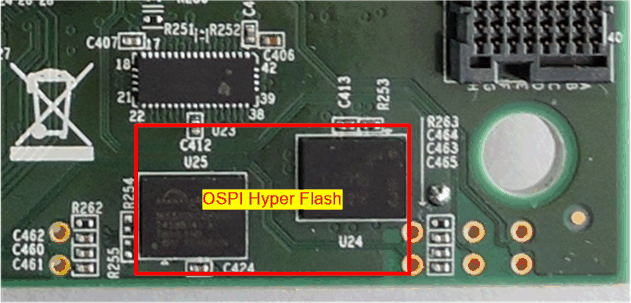SPRUIS4E March 2022 – January 2024
- 1
- Jacinto7 J721E/DRA829/TDA4VM Evaluation Module (EVM)
- Trademarks
- 1Introduction
- 2J721E EVM Overview
- 3EVM User Setup/Configuration
-
4J721E EVM Hardware Architecture
- 4.1 J721E EVM Hardware Top level Diagram
- 4.2 J721E EVM Interface Mapping
- 4.3 I2C Address Mapping
- 4.4 GPIO Mapping
- 4.5 Power Supply
- 4.6 Reset
- 4.7 Clock
- 4.8 Memory Interfaces
- 4.9 MCU Ethernet Interface
- 4.10 QSGMII Ethernet Interface
- 4.11 PCIe Interface
- 4.12 USB Interface
- 4.13 CAN Interface
- 4.14 FPD Interface (Audio Deserializer)
- 4.15 FPD Panel Interface (DSI Video Serializer)
- 4.16 Display Serial Interface (DSI) FPC
- 4.17 Audio Interface
- 4.18 Display Port Interface
- 4.19 MLB Interface
- 4.20 I3C Interface
- 4.21 ADC Interface
- 4.22 RTC Interface
- 4.23 Apple Authentication Header
- 4.24 EVM Expansion Connectors
- 4.25 ENET Expansion Connector
- 4.26 CSI Expansion Connector
- 5Revision History
4.8.2 OSPI Interface
The J721E SOM has 512 Mbit OSPI memory device of part number MT35XU512ABA1G12-0SIT connected to OSPI0 interface of J721E processor. The OSPI interface supports single and double data rates with memory speed up to 166 MHz SDR and 200 MHz DDR.
The SOM board also supports an option to include Hyper Flash + Hyper RAM Mfr. Part# S71KS512SC0, which is a 512 Mb flash + 64 Mb DRAM. 12-bit Active mux TS3DDR3812RUAR is provided to select either OSPI or HBMC interface. The selection of OSPI and hyper flash will be done by using a DIP (SW3) switch that is populated on the CP board. For more information, see Section 3.4.1.
 Figure 4-11 J721E SoM OSPI and Hyper Flash
Figure 4-11 J721E SoM OSPI and Hyper Flash